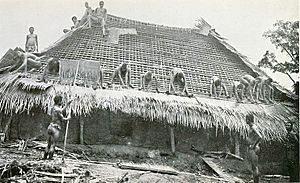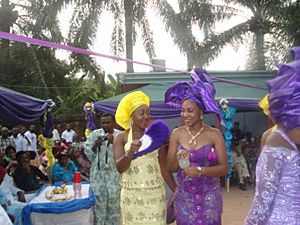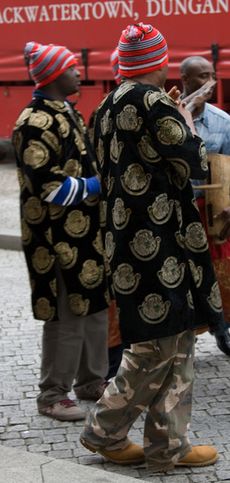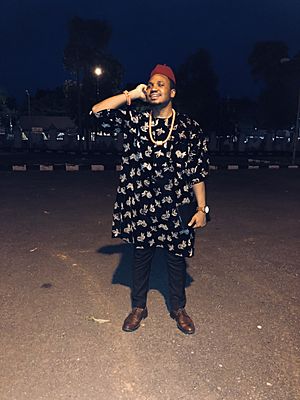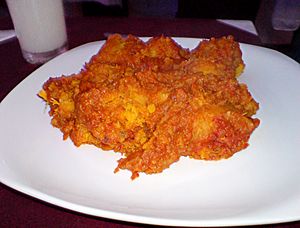Igbo people facts for kids
| Ṇ́dị́ Ìgbò | |
|---|---|

Location of the Igbo homeland (dark green)
in Nigeria (green) |
|
| Total population | |
| c. 45 million (2020 est.) | |
| Regions with significant populations | |
| Languages | |
| Religion | |
| Primarily Christianity, sometimes syncretised with indigenous Igbo religion and belief systems, | |
| Related ethnic groups | |
| Ibibio, Efik, Annang, Bahumono, Ogoni, Idoma, Igala, Urhobo, Ijaw, Ogoja, Krio; more remotely the YEAI group within Volta-Niger |
The Igbo people are a meta-ethnicity native to the present-day south-central and southeastern Nigeria and also Equatorial Guinea. There has been much speculation about the origins of the Igbo people, as it is unknown how exactly the group came to form. Geographically, the Igbo homeland is divided into two unequal sections by the Niger River – an eastern (which is the larger of the two) and a western section. The Igbo people are one of the largest ethnic groups in Africa.
The Igbo language is a part of the Niger-Congo language family. It is divided into numerous regional dialects, and somewhat mutually intelligible with the larger "Igboid" cluster. The Igbo homeland straddles the lower Niger River, east and south of the Edoid and Idomoid groups, and west of the Ibibioid (Cross River) cluster.
In rural Nigeria, Igbo people work mostly as craftsmen, farmers and traders. The most important crop is the yam. Other staple crops include cassava and taro.
Before British colonial rule in the 20th century, the Igbo were a politically fragmented group, with a number of centralized chiefdoms such as Nri, Aro Confederacy, Agbor and Onitsha. Frederick Lugard introduced the Eze system of "Warrant Chiefs". Unaffected by the Fulani War and the resulting spread of Islam in Nigeria in the 19th century, they became overwhelmingly Christian under colonization. In the wake of decolonisation, the Igbo developed a strong sense of ethnic identity. During the Nigerian Civil War of 1967–1970 the Igbo territories seceded as the short-lived Republic of Biafra. MASSOB, a sectarian organization formed in 1999, continues a non-violent struggle for an independent Igbo state.
Large ethnic Igbo populations are found in Cameroon, Gabon, and Equatorial Guinea, as well as outside Africa.
Contents
Culture
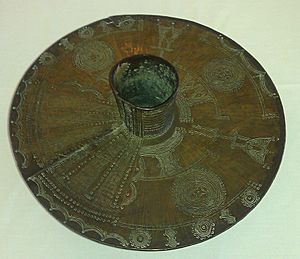
Igbo culture includes the various customs, practices and traditions of the people. It comprises archaic practices as well as new concepts added into the Igbo culture either through evolution or outside influences. These customs and traditions include the Igbo people's visual art, use of language, music and dance forms, as well as their attire, cuisine and language dialects. Because of their various subgroups, the variety of their culture is heightened further.
Language and literature

The Igbo language was used by John Goldsmith as an example to justify deviating from the classical linear model of phonology as laid out in The Sound Pattern of English. It is written in the Roman script as well as the Nsibidi formalized ideograms, which is used by the Ekpe society and Okonko fraternity, but is no longer widely used. Nsibidi ideography existed among the Igbo before the 16th century, but died out after it became popular among secret societies, who made Nsibidi a secret form of communication. Igbo language is difficult because of the huge number of dialects, its richness in prefixes and suffixes and its heavy intonation. Igbo is a tonal language and there are hundreds of different Igbo dialects and Igboid languages, such as the Ikwerre and Ekpeye languages. In 1939, Dr. Ida C. Ward led a research expedition on Igbo dialects which could possibly be used as a basis of a standard Igbo dialect, also known as Central Igbo. This dialect included that of the Owerri and Umuahia groups, including the Ohuhu dialect. This proposed dialect was gradually accepted by missionaries, writers, publishers, and Cambridge University.
In 1789, The Interesting Narrative of the Life of Olaudah Equiano was published in London, England, written by Olaudah Equiano, a former slave. The book featured 79 Igbo words. In the first and second chapter, the book illustrates various aspects of Igbo life based on Olaudah Equiano's life in his hometown of Essaka. Although the book was one of the first books published to include Igbo material, Geschichte der Mission der evangelischen Brüder auf den caraibischen Inseln St. Thomas, St. Croix und S. Jan (German: History of the Evangelical Brothers' Mission in the Caribbean Islands St. Thomas, St. Croix and St. John), published in 1777, written by the German missionary C. G. A. Oldendorp, was the first book to publish any Igbo material.
Perhaps the most popular and renowned novel that deals with the Igbo and their traditional life was the 1959 book by Chinua Achebe, Things Fall Apart. The novel concerns influences of British colonialism and Christian missionaries on a traditional Igbo community during an unspecified time in the late nineteenth or early 20th century. Most of the novel is set in Iguedo, one of nine villages on the lower Niger.
Performing arts
The Igbo people have a musical style into which they incorporate various percussion instruments: the udu, which is essentially designed from a clay jug; an ekwe, which is formed from a hollowed log; and the ogene, a hand bell designed from forged iron. Other instruments include opi, a wind instrument similar to the flute, igba, and ichaka. Another popular musical form among the Igbo is Highlife. A widely popular musical genre in West Africa, Highlife is a fusion of jazz and traditional music. The modern Igbo highlife is seen in the works of Dr Sir Warrior, Oliver De Coque, Bright Chimezie and Chief Osita Osadebe, who were among the most popular Igbo highlife musicians of the 20th century.
Masking is one of the most common art styles in Igboland and is linked strongly with Igbo traditional music. A mask can be made of wood or fabric, along with other materials including iron and vegetation. Masks have a variety of uses, mainly in social satires, religious rituals, secret society initiations (such as the Ekpe society) and public festivals, which now include Christmas time celebrations. Some of the best known include the Agbogho Mmuo (Igbo: Maiden spirit) masks of the Northern Igbo which represent the spirits of deceased maidens and their mothers with masks symbolizing beauty and Ijele.
Other impressive masks include Northern Igbo Ijele masks. At 12 feet (3.7 m) high, Ijele masks consist of platforms 6 feet (1.8 m) in diameter, supporting figures made of coloured cloth and representing everyday scenes with objects such as leopards. Ijele masks are used for honoring the dead to ensure the continuity and well-being of the community and are only seen on rare occasions such as the death of a prominent figure in the community.
There are many Igbo dance styles, but perhaps, Igbo dance is best known for its Atilogwu dance troops. These performances include acrobatic stunts such as high kicks and cartwheels, with each rhythm from the indigenous instruments indicating a movement to the dancer. The Egedege Dance is an Igbo traditional Royal-styled cultural dance and one of the most renowned traditional dances in the whole of South Eastern Nigeria.
Visual art and architecture
There is such variety among Igbo groups that it is not possible to define a general Igbo art style. Igbo art is known for various types of masquerade, masks and outfits symbolising people, animals, or abstract conceptions. Bronze castings found in the town of Igbo Ukwu from the 9th century, constitute the earliest sculptures discovered in Igboland. Here, the grave of a well-established man of distinction and a ritual store, dating from the 9th century AD, contained both chased copper objects and elaborate castings of leaded bronze. Along with these bronzes were 165,000 glass beads said to have originated in Egypt, Venice and India. Some popular Igbo art styles include Uli designs. The majority of the Igbo carve and use masks, although the function of masks vary from community to community.
Igbo art is noted for Mbari architecture.
Mbari houses of the Owerri-Igbo are large opened-sided square planned shelters. They house many life-sized, painted figures (sculpted in mud to appease the Alusi (deity) and Ala, the earth goddess, with other deities of thunder and water). Other sculptures are of officials, craftsmen, foreigners (mainly Europeans), animals, legendary creatures and ancestors. Mbari houses take years to build in what is regarded as a sacred process. When new ones are constructed, old ones are left to decay. Everyday houses were made of mud and thatched roofs with bare earth floors with carved design doors. Some houses had elaborate designs both in the interior and exterior. These designs could include Uli art designed by Igbo women.
One of the unique structures of Igbo culture was the Nsude Pyramids, at the town of Nsude, in Abaja, northern Igboland. Ten pyramidal structures were built of clay/mud. The first base section was 60 ft. in circumference and 3 ft. in height. The next stack was 45 ft. in circumference. Circular stacks continued, till it reached the top. The structures were temples for the god Ala/Uto, who was believed to reside at the top. A stick was placed at the top to represent the god's residence. The structures were laid in groups of five parallel to each other. Because it was built of clay/mud like the Deffufa of Nubia, time has taken its toll requiring periodic reconstruction.
Religion and rites of passage
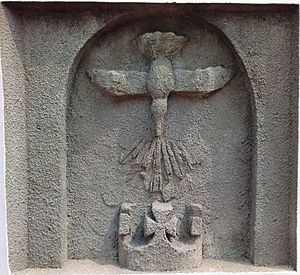
Most Igbo are Christian.
Christianity was first introduced to the Igbo people through European colonization in 1857. The Igbo people were hesitant to convert to Christianity initially because they believed the gods of their native religion would bring disaster to them. However, Christianity gradually gained converts in Igbo land, mainly through the work of church agents. These men built schools and focused on persuading the youth to adopt Christian values. The Igbo people today are known as the ethnic group that has adopted Christianity the most in all of Africa.
The Igbo people were unaffected by the Islamic jihad waged in Nigeria in the 19th century, but a small minority converted to Islam in the 20th century.
There is also a small population of Igbo Jews, some of whom merely identifying as Jews, while others having converted to Judaism. These draw their inspiration from Olaudah Equiano, a Christian-educated freed slave who remarked in his autobiography of 1789 on "the strong analogy which... appears to prevail in the manners and customs of my countrymen and those of the Jews, before they reached the Land of Promise, and particularly the patriarchs while they were yet in that pastoral state which is described in Genesis—an analogy, which alone would induce me to think that the one people had sprung from the other." Equiano's speculation has given rise to a great debate on the origins of the Igbo.
Native religion
The Igbo traditional religion is known as Odinani. The supreme deity is called Chukwu ("great spirit"); Chukwu created the world and everything in it and is associated with all things on Earth. They believe the Cosmos is divided into four complex parts: creation, known as Okike; supernatural forces or deities called Alusi; Mmuo, which are spirits; and Uwa, the world.
Chukwu is the supreme deity in Odinani as he is the creator, and the Igbo people believe that all things come from him and that everything on earth, heaven and the rest of the spiritual world is under his control. Linguistic studies of the Igbo language suggest that the name Chukwu is a compound of the Igbo words Chi (spiritual being) and Ukwu (great in size). Each individual is born with a spiritual guide/guardian angel or guardian principle, "Chi", unique to each individual and the individual's fate and destiny is determined by their Chi. Thus the Igbos say that the siblings may come of the same mother but no two people have the same Chi and thus different destinies for all. Alusi, alternatively known as Arusi or Arushi (depending on dialect), are minor deities that are worshiped and served in Odinani. There are many different Alusi, each with its own purpose. When an individual deity is no longer needed, or becomes too violent, it is discarded.

The Igbo have traditionally believed in reincarnation. People are believed to reincarnate into families that they were part of while alive. Before a relative dies, it is said that the soon to be deceased relative sometimes give clues of who they will reincarnate as in the family. Once a child is born, he or she is believed to give signs of who they have reincarnated from. This can be through behavior, physical traits and statements by the child. A diviner can help in detecting who the child has reincarnated from. It is considered an insult if a male is said to have reincarnated as a female.
Children are not allowed to call elders by their names without using an honorific (as this is considered disrespectful). As a sign of respect, children are required to greet elders when seeing them for the first time in the day. Children usually add the Igbo honorifics Mazi or Dede before an elder's name when addressing them.
Burials
After a death, the body of a prominent member of society is placed on a stool in a sitting posture and is clothed in the deceased's finest garments. Animal sacrifices may be offered and the dead person is well perfumed. Burial usually follows within 24 hours of death. In the 21st century, the head of a home is usually buried within the compound of his residence. Different types of deaths warrant different types of burials. This is determined by an individual's age, gender and status in society. Children are buried in hiding and out of sight; their burials usually take place in the early mornings and late nights. A simple untitled man is buried in front of his house and a simple mother is buried in her place of origin: in a garden or a farm-area that belonged to her father. In the 21st century, a majority of the Igbo bury their dead in the western way, although it is not uncommon for burials to be practiced in the traditional Igbo ways.
Marriage
The process of marrying usually involves asking the young woman's consent, introducing the woman to the man's family and the same for the man to the woman's family, testing the bride's character, checking the woman's family background, and paying the brides' wealth. Typically speaking, bride wealth is more symbolic. Nonetheless, kola nuts, wine, goats, and chickens, among other things, are listed in the proposal, as well. Negotiating the bride wealth can also take more than one day, giving both parties time for a ceremonial feast. Marriages were sometimes arranged from birth through negotiation of the two families. However, after a series of interviews conducted in the 1990s with 250 Igbo women, it was found that 94.4% of that sample population disapproved of arranged marriages.
Men sometimes married multiple wives for economic reasons so as to have more people in the family, including children, to help on farms. Christian and civil marriages have changed the Igbo family since colonization. Some Western marriage customs, such as weddings in a church, take place either before or after the lgbo cultural traditional marriage.
Attire
Traditionally, the attire of the Igbo generally consisted of little clothing, as the purpose of clothing originally was simply to conceal private parts. Uli body art was used to decorate both men and women in the form of lines forming patterns and shapes on the body.
Women traditionally carry their babies on their backs with a strip of clothing binding the two with a knot at her chest, a practice used by many ethnic groups across Africa. This method has been modernized in the form of the child carrier. Maidens usually wore a short wrapper with beads around their waist and other ornaments such as necklaces and beads. Both men and women wore wrappers. Men would wear loin cloths that wrapped round their waist and between their legs to be fastened at their back, the type of clothing appropriate for the intense heat as well as jobs such as farming.
In Olaudah Equiano's narrative, Equiano describes fragrances that were used by the Igbo in the community of Essaka:
Our principal luxury is in perfumes; one sort of these is an odoriferous wood of delicious fragrance: the other a kind of earth; a small portion of which thrown into the fire diffuses a most powerful odor. We beat this wood into powder, and mix it with palm oil; with which both men and women perfume themselves.
As colonialism became more influential, the Igbo adapted their dress customs. Clothing worn before colonialism became "traditional" and worn on cultural occasions. Modern Igbo traditional attire, for men, is generally made up of the Isiagu top, which resembles the Dashiki worn by other African groups. Isiagu (or Ishi agu) is usually patterned with lions' heads embroidered over the clothing and can be a plain colour. It is worn with trousers and can be worn with either a ceremonial title holders hat or with the conventional striped men's hat known as Okpu Agu. For women, a puffed sleeve blouse along with two wrappers and a head tie are worn.
Cuisine
The yam is very important to the Igbo as the staple crop. It is known for its resiliency (a yam can remain fully edible for six months without refrigeration), but it can also be very versatile in terms of its incorporation into different dishes. Yams can be fried, roasted, boiled, or made into a potage with tomatoes and herbs. The cultivation of yams is most commonly carried out by men, as women tend to focus on other crops.
There are celebrations such as the New yam festival (Igbo: Iwaji) which are held for the harvesting of the yam. During the festival, yam is eaten throughout the communities as celebration. Yam tubers are shown off by individuals as a sign of success and wealth. Rice has replaced yam for many ceremonial occasions. Other indigenous foods include cassava, garri, maize and plantains. Soups or stews are included in a typical meal, prepared with a vegetable (such as okra, of which the word derives from the Igbo language, Okwuru) to which pieces of fish, chicken, beef, or goat meat are added. Jollof rice is popular throughout West Africa and Palm wine is a popular alcoholic traditional beverage.
Images for kids
-
Bronze from the ninth century town of Igbo Ukwu, now at the British Museum
-
An Igbo man with facial scarifications, known as ichi, early 20th century
-
Wooden sculpture of Ikenga, an Alusi, in the Musée du Quai Branly.
-
Igbo people celebrating the New Yam festival in Dublin, Ireland
See also
 In Spanish: Pueblo igbo para niños
In Spanish: Pueblo igbo para niños


